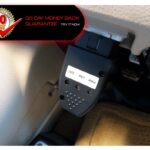This article provides information on OBD2 connection and smog checks for a 2005 Mercedes-Benz E320. Understanding how to connect to the OBD2 port and what to expect during a smog inspection is crucial for maintaining your vehicle’s emissions compliance.
While this article focuses on the 2005 E320, much of the information is relevant to other OBD2-compliant vehicles. However, always consult your vehicle’s specific repair manual for detailed instructions and troubleshooting.
Locating the OBD2 Port on a 2005 E320
The OBD2 port on a 2005 E320 is typically located under the dashboard on the driver’s side, near the steering column. It’s a 16-pin trapezoidal connector. You might need to remove a small panel or reach up under the dash to access it.
Smog Check and the OBD2 System
A smog check, also known as an emissions test, verifies that your vehicle meets state-mandated emissions standards. The OBD2 system plays a vital role in this process. It monitors various emission-related components and systems, storing Diagnostic Trouble Codes (DTCs) when malfunctions occur.
During a smog check, the technician will connect a scan tool to your E320’s OBD2 port. The tool retrieves information from the OBD2 system, including:
- Readiness Monitors: These self-tests confirm the functionality of emission control systems. Incomplete monitors can lead to a smog check failure. Common monitors include the catalytic converter, oxygen sensors, evaporative system, and EGR system.
- Diagnostic Trouble Codes (DTCs): Stored DTCs indicate specific malfunctions within the emission control system. These codes help pinpoint the source of a problem.
- MIL Status: The Malfunction Indicator Lamp (MIL), also known as the Check Engine light, illuminates when the OBD2 system detects a problem. A lit MIL will result in a smog check failure.
Common OBD2 Issues for a 2005 E320 Smog Check
While the E320 is generally reliable, some common OBD2-related issues can cause smog check failures:
- Incomplete Readiness Monitors: This can occur if the battery has been recently disconnected or if the vehicle hasn’t been driven under specific conditions required to complete the monitors. Driving the vehicle for a certain period under varying conditions can help complete the monitors.
- Oxygen Sensor Problems: Faulty oxygen sensors can affect fuel efficiency and emissions, leading to DTCs and a lit MIL.
- Catalytic Converter Issues: A failing catalytic converter will not effectively convert harmful pollutants, resulting in a smog check failure.
- Evaporative System Leaks: Leaks in the evaporative system, which prevents fuel vapors from escaping, can trigger DTCs and cause a smog check failure.
Troubleshooting OBD2 Connection Problems
If you’re having trouble connecting to the OBD2 port on your 2005 E320, check the following:
- OBD2 Port Condition: Ensure the port is clean and free of debris. Bent or damaged pins can prevent a proper connection.
- Fuse: Check the OBD2 fuse in your vehicle’s fuse box. A blown fuse will disable the OBD2 port. Consult your owner’s manual for the fuse location.
- Wiring: Inspect the wiring leading to the OBD2 port for any damage or loose connections.
Conclusion
Successfully passing a smog check with your 2005 E320 requires a properly functioning OBD2 system. Understanding the system, knowing how to connect to the OBD2 port, and addressing common issues can ensure your vehicle meets emissions standards. If you encounter persistent problems, consult a qualified mechanic for diagnosis and repair.

